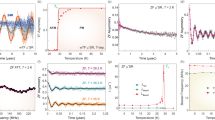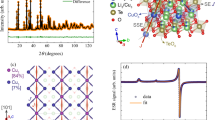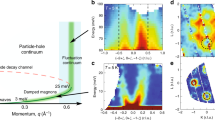Abstract
There are two main theoretical descriptions of antiferromagnets. The first arises from atomic physics, which predicts that atoms with unpaired electrons develop magnetic moments. In a solid, the coupling between moments on nearby ions then yields antiferromagnetic order at low temperatures1. The second description, based on the physics of electron fluids or ‘Fermi liquids’, states that Coulomb interactions can drive the fluid to adopt a more stable configuration by developing a spin density wave2,3. It is at present unknown which view is appropriate at a ‘quantum critical point’, where the antiferromagnetic transition temperature vanishes4,5,6,7. Here we report neutron scattering and bulk magnetometry measurements of the metal CeCu6-xAux, which allow us to discriminate between the two models. We find evidence for an atomically local contribution to the magnetic correlations which develops at the critical gold concentration (xc = 0.1 ), corresponding to a magnetic ordering temperature of zero. This contribution implies that a Fermi-liquid-destroying spin-localizing transition, unanticipated from the spin density wave description, coincides with the antiferromagnetic quantum critical point.
This is a preview of subscription content, access via your institution
Access options
Subscribe to this journal
Receive 51 print issues and online access
$199.00 per year
only $3.90 per issue
Buy this article
- Purchase on Springer Link
- Instant access to full article PDF
Prices may be subject to local taxes which are calculated during checkout




Similar content being viewed by others
References
Anderson, P. W. New approach to the theory of superexchange interactions. Phys. Rev. 115, 2–12 ( 1959).
Stoner, E. C. Proc. R. Soc. Lond. A 154, 656–678 (1936).
Overhauser, A. W. New mechanism of antiferromagnetism. Phys. Rev. Lett. 3, 414–415 (1959).
Hertz, J. A. Quantum critical phenomena. Phys. Rev. B 14, 1165–1184 (1976).
Millis, A. J. Effect of a nonzero temperature on quantum critical points in itinerant ferion systems. Phys. Rev. B 48, 7183– 7196 (1993).
Chakravarty, S., Halperin, B. I. & Nelson, D. R. Low temperature behavior of a 2D quantum antiferromagnet. Phys. Rev. Lett. 60, 1057– 1060 (1988).
Sachdev, S. & Ye, J. Universal quantum-critical dynamics of two-dimensional antiferromagnets. Phys. Rev. Lett. 69, 2411–2414 (1992).
Stewart, G. R., Fisk, Z. & Wire, M. S. New Ce heavy-fermion system: CeCu6. Phys. Rev. B 30, 482–484 (1984).
Onuki, Y., Shimizu, Y. & Komatsubara, T. Magnetic property of a new Kondo lattice intermetallic compound: CeCu6. J. Phys. Soc. Jpn 53, 1210–1213 (1984).
Doniach, S. The Kondo lattice and weak antiferromagnetism. Physica B 91, 231–234 (1977).
Aeppli, G. & Broholm, C. in Handbook on the Physics and Chemistry of Rare Earths Vol. 19 (ed. Gschneidner, K. A. Jr et al.) 123–175 (Elsevier, Amsterdam, 1994).
Mathur, N. D. et al. Magnetically mediated superconductivity in heavy fermion compounds. Nature 394, 39–43 (1998).
Varma, C. M., Littlewood, P. B., Schmitt-Rink, S., Abrahams, E. & Ruckenstein, A. E. Phenomenology of the normal state of Cu-O high temperature superconductors. Phys. Rev. Lett. 63, 1996–1999 ( 1989).
Löhneysen, H.v. et al. Non-Fermi-liquid behavior in a heavy-fermion alloy at a magnetic instability. Phys. Rev. Lett. 72, 3262– 3265 (1994).
Stockert, O., Löhneysen, H.v., Rosch, A., Pyka, N. & Loewenhaupt, M. Two-dimensional fluctuations at the quantum-critical point of CeCu6-xAux. Phys. Rev. Lett. 80, 5627– 5630 (1998).
Löhneysen, H.v. et al. Magnetic order and transport in the heavy-fermion system CeCu 6-xAux. Eur. Phys. J. B 5, 447–456 (1998).
Schröder, A., Aeppli, G., Bucher, E., Ramazashvili, R. & Coleman, P. Scaling of magnetic fluctuations near a quantum phase transition. Phys. Rev. Lett. 80, 5623– 5626 (1998).
Rosch, A., Schröder, A., Stockert, O. & Löhneysen, H.v. Mechanism for the non-Fermi-liquid behavior in CeCu6-xAu x. Phys. Rev. Lett. 79, 159– 162 (1997).
Ruck, M. et al. Structure and electrical resistivity of the heavy fermion compound CeCu5Au. Acta Crystallogr. B 49, 936–941 (1993).
Schröder, A., Lynn, J. W., Erwin, R. W., Loewenhaupt, M. & Löhneysen, H.v. Magnetic structure of the heavy fermion alloy CeCu5.5Au0.5. Physica B 199–200, 47–48 ( 1994).
Stockert, O. et al. Incommensurate antiferromagnetism and magnetic correlations in CeCu6-xAux. Physica B 230–232, 247–249 ( 1997).
Si, Q., Smith, J. L. & Ingersent, K. Quantum critical behavior in Kondo systems. Int. J. Mod. Phys. 13, 2331–2342 (1999).
Rosch, A. Interplay of disorder and spin fluctuations in the resistivity near a quantum critical point. Phys. Rev. Lett. 82, 4280 –4283 (1999).
Doniach, S. in Proc 5th Int. Conf. on Valence Fluctuations 179– 185 (Plenum, New York, 1987).
Moriya, T. & Takimoto, T. Anomalous properties around magnetic instability in heavy electron systems. J. Phys. Soc. Jpn. 64, 960–969 (1995).
Aronson, M. C. et al. Non-Fermi-liquid scaling of the magnetic response in UCu 5-xPdx (x = 1,1.5). Phys. Rev. Lett. 75, 725–728 ( 1995).
Schröder, A., Schlager, H. G. & Löhneysen, H.v. Magnetization of CeCu6 at low temperatures. J. Magn. Magn. Mater. 108, 47–49 (1992).
Carlile, C. J. & Adams, M. A. The design of the IRIS inelastic neutron spectrometer and improvements to its analysers. Physica B 182, 431–440 (1992).
Sachdev, S. Quantum phase transitions and conserved charges. Z. Phys. B 94, 469–479 (1994).
Castro Neto, A. H., Castilla, G. & Jones, B. A. Non-Fermi liquid behavior and Griffiths phase in f-electron compounds. Phys. Rev. Lett. 81, 3531–3534 (1996).
Acknowledgements
A.S., O.S. and H.v.L. were supported by the Deutsche Forschungsgemeinschaft; R.C. was supported by the Oak Ridge National Laboratory Postdoctoral Research Associates program, administered jointly by the Oak Ridge National Laboratory and the Oak Ridge Institute for Science and Education; P.C. and R.R. were supported by the National Science Foundation. R.R. acknowledges partial support from the MacArthur Chair endowed by the John D. & Catherine T. MacArthur Foundation at the University of Illinois.
Author information
Authors and Affiliations
Corresponding author
Rights and permissions
About this article
Cite this article
Schröder, A., Aeppli, G., Coldea, R. et al. Onset of antiferromagnetism in heavy-fermion metals. Nature 407, 351–355 (2000). https://doi.org/10.1038/35030039
Received:
Accepted:
Issue Date:
DOI: https://doi.org/10.1038/35030039
This article is cited by
-
Proximate spin liquid and fractionalization in the triangular antiferromagnet KYbSe2
Nature Physics (2024)
-
Evidence for charge delocalization crossover in the quantum critical superconductor CeRhIn5
Nature Communications (2023)
-
Weak-coupling to strong-coupling quantum criticality crossover in a Kitaev quantum spin liquid α-RuCl3
npj Quantum Materials (2023)
-
Critical slowing down near a magnetic quantum phase transition with fermionic breakdown
Nature Physics (2023)
-
Field-induced quantum critical point in the itinerant antiferromagnet Ti3Cu4
Communications Physics (2022)
Comments
By submitting a comment you agree to abide by our Terms and Community Guidelines. If you find something abusive or that does not comply with our terms or guidelines please flag it as inappropriate.



